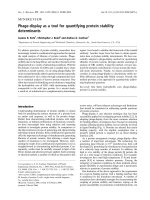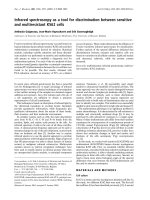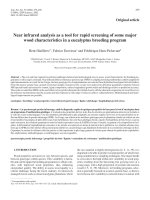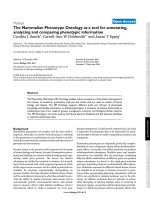Plc as a tool for marketing strategy asignment
Bạn đang xem bản rút gọn của tài liệu. Xem và tải ngay bản đầy đủ của tài liệu tại đây (150.43 KB, 14 trang )
1. Explain various concepts of marketing with suitable examples?
2. Explain market segmentation with suitable examples?
3. “PLC as a tool for marketing strategy” justify?
4. Explain process of selecting the final price?
5. Explain the process of integrated Marketing communication?
CONTENT
I. INTRODUCTION
Today, commodity markets or services are almost no longer bounded by territory borders,
geographical distance and marketing is not only to sell goods or services, but also perform the
function of bringing customers closer to companies. Or there is interaction and relationship
between customers and companies toward the goal to satisfy each other's needs through
products or services. Marketing management and establishing a marketing mechanism with a
focus on customers is a core factor in the sustainable development of enterprises, satisfying
customers’ needs and ensuring living environment of human.
In order to make sure for the success in the context of a severe competition and the current
globalization, a company should clearly identify its strengths as well as limitations to choose
for itself the unique products or services with outstanding advantages for integrating into a
larger market but lacking space for any companies which don’t have appropriate marketing
strategies and don’t understand the complex fluctuations of the market.
After studying marketing management under the guidance of lecturer, I decided to choose
some content to do my assignment, including: i) Explain various concepts of marketing with
suitable examples; ii) Explain market segmentation with suitable examples; iii) “PLC as a tool
for marketing strategy” justify; iv) Explain process of selecting the final price and Explain the
process of integrated Marketing communication.
Page 1
II. BODY
1. Explain various concepts of marketing with suitable examples?
Marketing management is the conscious effort to achieve desired exchange results with target
markets. If marketing managers are in favor of any philosophy, they will enhance the
activities towards that direction, if they want a market with many cheap products distributed,
they will concentrate all the enterprise’s resources to strengthen the production. In business
activities, depending on awareness each enterprise can have different thoughts and
philosophies. There are five basic philosophies of marketing management as the following:
1.1 The Production Concept
Focus on production duties, because in this sense that customers will benefit due to the
availability and widely distributed at low prices, the marketing management should focus on
boosting production as well as product distribution. This concept is often explained by two
main reasons:
- First, when demand for a product exceeds the supply, the customers will pay much
attention to getting the product to consume rather than focus on the subtle attributes of product
quality. Therefore, the company will focus on increasing the scale of production with the
desire to increase sales volume and profitability.
- Second, to reduce production costs, the company will look to increase production to
achieve economies of scale and thereby expand the market.
Positive aspects of this concept are evident when demand exceeds supply. However, the
biggest drawback is the occurrence of oversupply situation (will cause excess waste due to the
absence of a sale, the revenue could not offset the cost spent); or lower price as well as the
ease of shopping (due to the wide distribution) are not the major factors to attract customers in
purchasing decisions.
1.2 The Product Concept
Page 2
Focus on the products, so that customers will benefit most when offered the same quality
products of unique design with innovative features. Thus, the marketing management will
prioritize efforts to improve the quality of products continuously. But to ensure the effective
business, managers should be aware how to properly consider the needs and demands of
customers. Positive aspects of this concept will promote market to have many good products,
but it will have difficulties due to appearing risks of alternative products increased, and
customers will buy the alternative products with better uses and benefits instead of choosing
high quality products but less efficiency.
1.3 The Selling Concept
Focus on the task of selling, because it can attract customers and if not actively selling and
implementing strong promotions, customers will not buy all products. This concept is applied
strongly to detect the prospective customers and pressed by convinced of the benefits, as
unsought goods that normally buyers do not think the premium, functional foods... or sought
goods but expensive as houses, cars... The downside of this concept is making many potential
customers to be surrounded by the advertising, promotion too much, so it will make them feel
at any time, any place there are people trying to sell a something, and they will shy away.
1.4 The Marketing Concept
This is one of the cornerstones of the modern business concepts. Marketing concept confirms
the key to achieve the objectives of the organization to lie in determining the needs and wants
of the target markets, and distributing the satisfaction effectively than competitors. This
concept focuses on the satisfaction of the consumers to bring success, so the company should
only offer products under customers’ desire. However, its drawback is not to pay attention to
social welfare.
1.5 The Societal Marketing Concept
Not only bring customer satisfaction but also to ensure the social benefits, it is the societal
marketing concept. This is almost a step further than the marketing concept, because it was
Page 3
believed that only the satisfaction of consumers is not enough, but also the sustainable
development must also focus on protecting the interests of the whole society.
If a company produces a car consuming less gas but polluting more, then, to a certain extent,
it has brought satisfaction to consumers but damaged the living environment
Before the companies have made marketing major decisions based on profit, but now
satisfying customer needs and perceptions of the importance of the social benefits have been
focusing more and more. As a result, marketing activities will be significantly better with the
longer-term benefits.
Choosing one of the above five philosophies of marketing management depends on a lot of
factors such as: Competitive position of the enterprise, the characteristics of products or
services, the demand of target market, the ability of enterprise’s marketing staff. Therefore,
applying a philosophy will depend on capacity of a company, market situation and other
social objectives to have tight dominance in accordance with the actual conditions and avoid
restrictions in order to bring the best results.
The fact that the company can manufacture products that are cheap and widely distributed or,
focus on improving to make products with high quality as well as promote products with the
hope of selling more products or meeting customer’s demand better and better to satisfy them
is really not enough for companies today. These factors are necessary but the most important
thing in marketing is to bring the highest satisfaction to customers, contributing to achieve
business goals and promote social benefits.
2. Explain market segmentation with suitable examples?
Market segmentation is a marketing strategy that involves dividing dividing a broad target
market into smaller segments that fit the needs of a group of customers who have common
needs and application of the goods and related services. Depending on the specific
characteristics of products, these segments can be divided according to criteria such as age
and gender, or other discrimination, such as location or income. Accordingly, the marketing
campaign is designed and implemented to target segments of specific customer.
Page 4
In business, the company in market segment to improve competitiveness and profitability in
ways as follows:
- By focusing on product development, marketing, resources and services on the most
promising segment, the companes can deploy effective marketing.
- By developing products, services, and marketing messages to address the specific
needs of the segment, the companies can improve their market share in the best way. At the
same time, by focusing on the needs of customers to enhance the attractiveness to customers.
A good segment of the market is determined by the following five criteria: Be possible to
identify and measure; Be large enough to be effective; Be easy to hold; Stability; And
responsiveness. Market segmentation strategies to meet these criteria can include the wide
range of consumer characteristics. These small segments can be determined by a number of
personal characteristics such as race, gender, age or education level and income, but
particularly social class, lifestyle and interests of customers. In most segments mentioned
above, there will be some customers may be relatively consistent with the criteria of multiple
groups. This overlap often leads to a new segment incurred a drag on demand adjustment of
marketing strategy. Therefore, a targeted marketing plan for some customers may be more
effective if focused on a particular trait.
Other Benefits: Along with roles in innovation marketing methods, market segment can also
help the companies identify ways to improve customer loyalty. As part of the process of
identifying specific groups of potential customers, the companies will often conduct surveys
to understand customer requirements to improve products or services. This can lead to
changes in packaging or some other similar parts that do not necessarily have an impact on
core products, and sometimes make such simple changes make the customers feel their needs
to be important to the companies. The result is to promote the relationship between the
consumers and the manufacturers. Market segment is not only beneficial for the companies or
distributors, but sometimes there are benefits for customers. Customers in a market segment
can benefit when the companies focus on those products that fit such group requests, or find
Page 5
the more popular products. When the companies meet customer feedback, which means that
the companies better meet customer requirements.
The drawbacks of the market segment: One of the biggest drawbacks in the market
segment is expenses. Because the companies often need to spend a lot of time and money to
perform market research to determine exactly what the most important segment for
themselves, then the different marketing messages need to be deployed. In addition, each
change of a product in each segment is forced the companies to invest more expenses in order
to adjust. So all investment resources will be wasted if the market is not effectively segment.
When defining a narrow market segment, the benefits of the companies can be not good
because sales are not high, it is difficult to offset the costs spent, it can not be profitable or
have but very low so not worth the investment. The challenge occurs when the customer
tastes change or appearing strong competitors in selected segments of a company, a company
focusing too much on one segment may lose its customers in other segments quickly.
Targeting smaller segments means that the companies may have overlooked other potential
customers and lost business opportunities.
3. “PLC as a tool for marketing strategy” justify?
The development stages in the life of a product is known as the “Product Life Cycle”. Product
Life Cycle is a famous concept in marketing to describe four distinct stages a product:
Introduction, Growth, Maturity and Decline. Not all products reach this final stage. Some
continue to grow and others rise and fall. Companies should be aware of the stages in which
theirs products are in to have a marketing plan: Launching a new product, refreshing an old
product or simply replacing the old products with the new ones. In other words, to help
companies with a lot of applications in product management and pricing strategy, and
marketing budget management.
3.1 Introduction Stage: This is the initial stage, customers do not know or do not
know much about the products, the companies have a lot of costs to introduce and advertise
products on the market.
Page 6
3.2 However, if the companies implement pricing strategies, product positioning error
would create the risk of reducing the value of the products. In terms of market size is too
small will not be able to have good sales, so the companies must rethink marketing strategies
if the market uncertainty. Target customers who are interested in exploring and
experimenting, and they always want to be the first to use the products.
3.3 Growth Stage: After the initial stage, many customers were interested in those
products due to their value brought, as well as from the effects of marketing activities and
through the targeted customers. The property of products becomes a great demand, the
number of products sold will increase, the companies will have greater revenue and
profitability. When products are dominant and dominant market, they will bring the biggest
profit margin.
3.4 Maturity Stage: After the development stage, the number of customers has owned
high products, so the attractiveness of the products is not as large as before and the demand
for products gradually becomes saturated. Sales will be leveled off and begun to decline over
time due to the emergence of many competitors, loss of market share or products unfit for
consumers. At this stage, the companies need to deploy marketing strategies for new products
or for the lifetime of the product line instead.
3.5 Decline Stage: Products have become too familiar and not so attractive, so
consumers have been boring and appeared psychological to want more new products and
more features. So this time, purchases fell, sharply increased cost of sales and reduced profits.
The companies should reduce the price to attract customers in lower segment and to have
revenue in the period.
Marketing strategy is to identify what the market needs, basing on the formation and
development of a product. The task of marketing is to research the market demand,
manufacture products that satisfy those needs and promote the development of products to
expand markets and increase the company’s profits. A marketing strategy will help a
company focus and identify the different ways to talk to customers, and concentrate on the
Page 7
ones that will create most sales. A successful marketing strategy depends on understanding
your customers, what they need and how you can persuade them to buy from you.
Therefore, for each stage of the PLC, a company should develop and engage in a variety of
appropriate marketing tasks to exploit the strengths of the product and market. Every product
has a life expectancy and marketers must correctly identify each stage of the product life cycle
to develop the appropriate marketing. They have to try to keep the products not fall into
decline stage with appropriate transition steps by launching alternative products with more
advantages at the right time to attract the best target customers and maximize profits.
4. Explain process of selecting the final price?
Price is the quantity of payment in return for goods or services or it is the sum of all the
benefits when possessing or using goods or services. In the past, price is the main factor
affecting a buyer’s decision. But today the non-price factors become more important, as a
result, many products or services have the proportion of non-price factors much higher than
the their tangible value. Today, there is almost no existence of border concept for markets.
Because there are many suppliers for the same products, the price competition has become the
number one problem that administrators have to face. The companies must establish a price
for the first time when developing a new product, when introduced into a new distribution
channel or geographical area. This is usually done as follows:
- Identify target market segments for products or services, with expectations to achieve
and how to deliver products or services to access it.
- Establish the level of consumer prices for the target market segment.
- Check prices (and costs if possible) of the actual or potential competitors.
- Check prices range from the different levels of quality or product delivery method.
- Identify profitable could get at each price .
- If low profits, to change specifications of products to reduce the cost to generate the
desired profit.
Page 8
The order to set pricing policies:
4.1 Selecting the Pricing Objective
This is the most important stage. The clearer objectives, the easier setting prices. Five major
objectives through pricing are: The survival of the companies, the maximum profit, maximum
market share, maximum surf market and product quality management. Although specific
objectives, the companies use price as a strategic tool that will benefit more than the
companies simply for cost or market valuation of their products.
Sony is one company that has experienced surf market. They sell very high price when
launching a high technology product to market for consumer groups having a lot of money
(premium segment), and the purchasing power decline in this segment, they will reduce the
price to attract purchasing power in lower market segments.
4.2 Determining the demand
The next stage is to identify needs. Each price level will create different needs towards be
inversely proportional to each other and have different impacts on marketing objectives. Most
customers are sensitive to the price of the products of the essential goods. A seller can charge
a higher price than competitors and still sell as long as the customers can own with the lowest
cost. The process of estimating demand, leading to: i) Estimation of sensitivity; ii) Evaluation
and analysis of the demand; iii) Determination of the price elasticity of demand.
4.3 Estimating Costs
Cost of products include: costs for production, distribution and sale of products (including the
favorable factors and risks). This cost depends on each different production levels.
4.4 Analyzing competitor's costs, prices and offers
This is an important factor. This stage depends on market demand and the cost of the
products, the cost of competitors and the reaction may be of price. In particular, if the poor
products or services, the companies will not be calculated as high as their competitors, on the
other hand they can also change prices to compete with the cost of the companies.
Page 9
4.5 Selecting a pricing method
There are three pricing methods be used: 1) Costs oriented prices; 2) Competitors oriented
prices; 3) Marketing oriented prices.
Costs oriented prices: Two methods are commonly used:
- Full costs: Synthetic full costs associated, however this method has weaknesses lead to
an increase in prices, as opposed to the affordability of potential customers.
- Direct costs: Only for the costs are to increase as production increased, helping
determine the lowest price to increase profits while reducing prices to increase sales during
peak hours. The discount for the vacant seats on the plane is to attract more passengers.
Competitors oriented prices:Market pricing: Based largely on prices of competitos, may
equal, more than, or less than competitors. In case of pricing higher than competitors, the
companies need through the delivery schedule or quality of services to justify a higher selling
price. Competitive bidding: The buyers will choose the lowest cost providers.
Marketing oriented prices: The price of a product is set to match the marketing strategy. For
new products, prices will depend on locations and strategies; existing products will be
affected by strategic objectives.
4.6 Selecting the final Price
This stage is to narrow down the companies’ choices in its final prices, to consider additional
factors such as psychological prices, favorable and riskable prices, the impact of marketing,
company policies and effects, the impact on market prices.
A purchaser’s concern about prices is related to their expectations about the satisfaction or the
utility of products. Sometimes, high prices can attract customers and bring high profits while
low prices don’t appeal and even fail. For customers they always have to decide whether the
utility achieved in an exchange corresponding to the amount of money they pay for it or not.
Therefore, the process of setting costs to reach a price for each stage in order to launch a
product or service for the market in the most beneficial way: Achieve the original goals of the
Page 10
company, in which attracting target customers of each stage to get maximum profits in the
long term, contribute to a company’s development. With 6 steps above, depending on the
specific conditions that a company should choose some appropriate steps to take priority over
others in order to achieve the best goals.
5. Explain the process of integrated Marketing communication?
Integrated Marketing Communications (IMC) is planning a marketing communication
strategy by coordinating tools of advertising, promotions, public relations, digital marketing...
for them to work in concert to communicate the messages about the products, brands and the
companies to customers clear, steady and consistent in order to provide maximum efficiency.
Communication process: Integrated marketing communications use communication process
to persuade potential customers to listen and act upon the marketing messages. Implement
marketing how to target customers interested, confident and willing to spend money to buy
products and services is always a challenge for managers. Recently, online marketing has
grown in comparison with previous forms of marketing such as advertising through mass
media, personal selling, direct mail... Because there may be many messages in many forms of
marketing from too many companies, it requires managers to provide a consistent message
when customer contact. The answer is that managers should have a marketing communication
strategy in coordination and allocation of financial resources a good way of tools of
advertising, promotions, public relations, digital marketing for them to do the same work in
concert to communicate messages about products, brands and the companies to customers
clear, steady and consistent in order to provide maximum efficiency, often referred to as
Integrated Marketing communications (IMC).
IMC’s mission is to bring targeted customers to buy the products and services. The impact to
customers that are shopping via the following process:
5.1 Develop awareness: Customers will not want to buy or use if they have not heard
or have awareness about a product or service, so the companies need to spend so much effort
Page 11
to explore the market, approach customers to build this awareness. For customers, when there
is information on benefits will arise desire to further understand and appear the use needs.
Informing policies of electricity price for poor people: From when? From that point on, the
next was, what is the purpose? What is the next, what is the purpose?
5.2 Provide knowledge: A stage to provide information about the characteristics of the
products or services. What products? What tools? How is the quality?
The Power Companies have propagated fully and directly to poor households that if the
amount of power they use per month is less than 50 kWh, they will only have to pay for the
electricity with the price the same with the production costs, about 993VND/kWh, lower than
425 VND compared with the first 50 kWh using of other households; besides, the State will
support 30.000 VND per month.
5.3 Create a positive impression: Characterizations of the products or services are
information for customers to compare with other products or services in selected thoughts,
and this stage for potential customers to see the benefits of the products or services (which
will help customers have a better life, save money or solve problems) to influence their
purchasing decisions.
Policies of electricity price for poor people bring customers two benefits: They can save
21.250 VND per month compared with normal and they can gain 30.000 VND from the
support of the State.
5.4 Achieve favorable positions in the consumer’s mind: Favorable factors have
positive implications in customer’s mind and significantly impact the decisions to buy the
products or services.
If customers continue to use the power of less than 50 kWh per month, they not only monetary
benefits in the next few months, but also contribute to energy savings for society and for the
use of fossil fuels less, keep a better living environment. The convenience is much appreciated
customers, as they balance the benefits and responsibilities, and it is also using electrical
solutions very well.
Page 12
5.5 Create interest to buy products: Customers will determine or significantly impact
the purchasing decisions of others if marketing does good stages outlined above, in which the
right of customers, many who have the ability to attract others to buy them.
The fact that saving 255.000 VND per year is not a big problem but the saving amount of a
year can be spent for other needs.
Transact: After completing the stages above, this is to take the target customers to buy the
products or services, potential customers become actual customers, as a result of process of
integrated marketing communications.
III. CONCLUSION
For marketing philosophies, any philosophy has its strengths and helps administrators follow
a particular direction in the marketing activities of the enterprise. But these philosophies show
better in each of the separate business activities. It is important for administrators to identify
what philosophy that their companies need in a certain period to emphasize. And with the
signification for sustainable development of a company, the Societal Marketing Concept is on
top priority of many responsible companies.
One of the main reasons to use market segmentation is to help companies understand better
the needs of specific customers. The ways and marketing content for each segment will be far
more effective compared with general implementation for all customers. By identifying the
differences of each group of potential customers, the marketing message will aim to better
target, closely meet customer’s needs and desire, and enhance the overall effectiveness of the
company’s marketing efforts.
Today, together with many progress in science and technology, we have a lot of new
products. However, besides this, there is an increasingly fierce competition, therefore, the
product life cycle also become shorter, even cannot go through all the normal stages. This
require administrators to have to find ways to stop the decline with the continuous
improvement solutions in order to make customers feel their tastes are always responded
better and better with value added time to time.
Page 13
Besides, to make sure for the products to be accepted, quickly dominating the goal market is
to establish the most appropriate prices in order to gain not only the enterprise’s objective
market, but also to ensure profits for the survival and development of an enterprise. And in the
business activities, each enterprise should always know how to identify the necessary
marketing tools and coordinate them in a certain extent according to the conditions of their
own at a suitable time with the best effectiveness.
IV. REFERENCES
/> /> /> /> /> /> />marketing-strategies/
/>product-life-cycle
/>conduct-marketing-activities/
/>management-philosophy/1076/
/>marketing-strategies/images/product-life-cycle-stages/
Page 14









